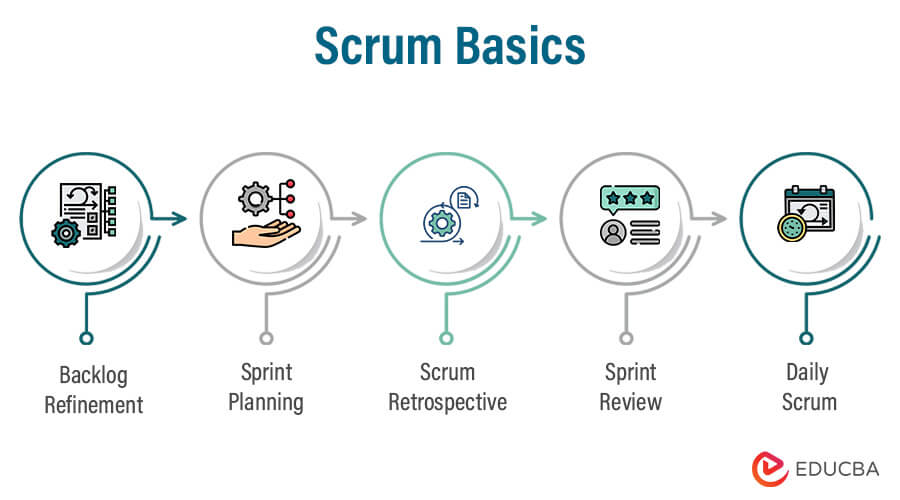Updated May 22, 2023
Introduction to Scrum Basics
Scrum basic is a straightforward process that helps to make products in chunks and in iterations, to adhere to the fluctuating market needs as well as the stringent goals of the organization.
Roles in a Scrum
The scrum team has three roles: a Product Owner, the Development Team, and a Scrum Master.
1. Owner of the product
- Creating an organizational vision.
- It is a representation of the business and marks the Return on Investment.
- Passes on the vision to the teams involved.
- Takes ownership of the backlog.
- It makes market needs a priority.
- It is the decision-maker for the teams.
- Mediates between the team and the customers to deliver the ultimate deliverable as per needs and on time.
2. Team for development
- Self-managed – The team is self-managed, and the work front decision is mutually taken.
- Independent – The team is empowered to make its own decisions.
- No designation – The team has no designation, and each member has the necessary skills to deliver the required work.
- Small teams – The Development teams are ideally small-sized with 5-9 members.
3. Master of the Scrum
- Leader – Coaches the teams on various aspects of Scrum basic, guides them on how to proceed on the work front, and hence, reaps the advantages of Scrum.
- Helps eliminate obstacles – Helps development teams remove all the obstacles on the path of progress and help them evolve.
- Identifies ways to collaborate – Facilitates the team with everything it needs to deliver the ultimate product.
- Helps teams stay secure – Ensures that no external factor can influence the team in any way.
Artifacts of a Scrum
We employ documentation to track work progress rather than for collaboration purposes. Working software always measures this progress. Documentation in Scrum is only through four main artifacts: Product backlog, Sprint backlog, Increment, and Definition of Done.
1. Backlog of the product
- Evolves as per market needs.
- Lists all the requirements needed to deliver quality products.
- It is updated continuously.
2. Backlog of the sprint
- We aim to finish a subset of product backlog items in one sprint.
- Items are divided into small chunks.
- Focused on how to deliver work in a single sprint.
- Helps prioritize work per the customer’s requirements and the final deliverable.
- We help teams supervise the progress and ensure goal alignment.
3. Product Increment
The work delivered at the end of each sprint is called an increment. At the end of each iteration, we get a Product Increment (PI) that promises to deliver value, and in the end, we get our required product.
4. What is Done?
‘Definition of done’ in a scrum helps teams specify a work as done. This is how teams can estimate how much work has been completed.
Activities in a Scrum Basics
The team performs Scrum activities in iterations, utilizing the time for preparation and applying all the learnings.
Scrum activities include:
- Product Backlog Refinement
- Sprint Planning
- Daily Scrum
- Sprint Review
- Sprint Retrospective
1. Refinement of product backlog
- Eliminates product backlog items that are not a priority anymore.
- Includes product backlog items that are not a priority anymore.
- Divides product backlog items into chunks.
2. Planning a Sprint
- Negotiates product backlog items in the presence of the Product Owner.
- It enables a mature understanding of the work process.
- Completes smaller items on a priority basis.
- We properly plan and complete the work.
To ensure that the above requirements are fulfilled, we need to do the following:
- What is the work to be done?
- How should the identified work be done?
3. Daily meeting of a Scrum
The daily Scrum is a meeting held every morning for a maximum of 15 minutes. This is also known as the daily stand-up meeting. It includes:
- What was my contribution at work yesterday?
- What shall be my contribution today?
- Are there any hassles interrupting me in between?
4. Review of the Sprint
- A proper illustration of the work process with an explanation of the product’s features.
- Feedback on the product lets us know the lacuna in the deliverable, which can be worked upon.
- The Scrum master calls for a meeting in which the teams involved and all the stakeholders attend to discuss the developed product and the work process followed.
5. Retrospective Scrum analysis
- The team reviewed and enquired about what went well regarding collaboration, planning, process, and tools.
- They find the lacuna and help improve the process and the team members’ competence.
- They plan and take a firm stance on proceeding from one sprint to another.
- The team takes responsibility for continually improving the entire work cycle until delivery.
The three questions every team member needs to answer:
- What do we need to start doing?
- What do we need to stop doing?
- What do we need to maintain doing?
Conclusion
- Despite being so precise and efficient, Scrum has its limitations:
- Geographically scattered teams find it difficult to carry out such an extensive framework.
- Such an extensive framework does not work for team members with specific skills.
- We cannot control certain aspects of Scrum concerning external facts.
- Such a framework does not fit a few products as they have specialized features.
Recommended Articles
This has been a guide to Scrum Basics. Here we have discussed the basic concept, roles in Scrum, artifacts of a Scrum, and the various activities of a Scrum. You may also look at the following articles to learn more –




